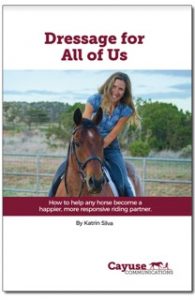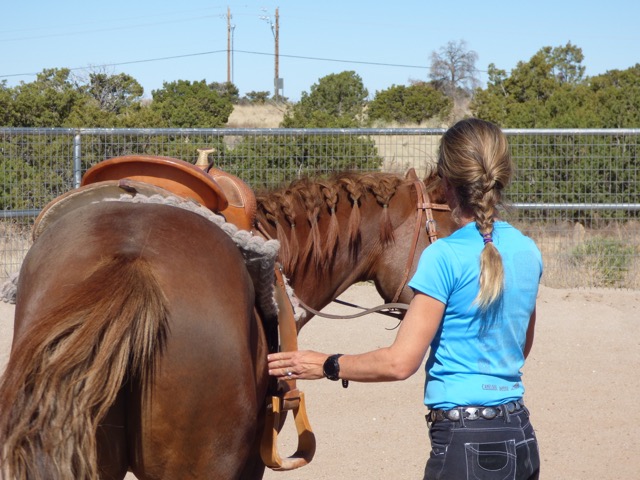 Editor’s Note: Best Horse Practices Summit presenter Katrin Silva grew up riding dressage in Germany before moving to the United States at age 19 to learn to ride Western. She’s been riding both disciplines for the last twenty years and is a regular guest columnist for Cayuse Communications. She lives in New Mexico where she works with dressage and Western clients. Visit her blog here.
Editor’s Note: Best Horse Practices Summit presenter Katrin Silva grew up riding dressage in Germany before moving to the United States at age 19 to learn to ride Western. She’s been riding both disciplines for the last twenty years and is a regular guest columnist for Cayuse Communications. She lives in New Mexico where she works with dressage and Western clients. Visit her blog here.
Check out her new book, “Dressage for All of Us: How to help any horse become a happier, more responsive riding partner.”
Silva writes:
For many of my 30 years as a trainer, I’ve started colts for clients. I still start a few colts and every year, I swear I will stop. But every year, I end up doing it again, mostly because I realize more and more how important it is to give young horses a good foundation.
What, exactly, is the right way to start a horse? There are many.
- I use a western saddle and work in a round pen, because that’s how I learned to do it.
- I use a snaffle bit.
- Sometimes, I ground drive the horse.
- With a few horses, I pull out my “serape-man” (a contraption made from saddle blankets and baling twine, designed to feel like a rider’s legs) before I swing a leg over the horse’s back for the first time.
 My system has always worked well for me, but I know excellent trainers who use other equipment and other systems.
My system has always worked well for me, but I know excellent trainers who use other equipment and other systems.
- Instead of a western saddle, they use an all-purpose saddle, or no saddle at all.
- Instead of a snaffle, they use a bosal, a rope halter, or a side pull. Some work with a clicker and treats, some with a flag, some with a lunge whip (which they may or may not call by that name).
- Some trainers don’t use round pens, but get on in the horse’s stall the first few times. Some use a bigger arena, a lunge line, and a couple of helpers on the ground. Others pony their green horses, first without and then with a rider.
Which way is the best one?
 It’s not my way or anyone else’s way. It’s not something you can learn from watching videos or spending a weekend at a clinic. The type of tack you use is not that important. The exact method you use is not that important. And yet, good colt starters have much more in common with each other that what it seems.
It’s not my way or anyone else’s way. It’s not something you can learn from watching videos or spending a weekend at a clinic. The type of tack you use is not that important. The exact method you use is not that important. And yet, good colt starters have much more in common with each other that what it seems.
- 1. Good colt starters are calm. Like islands in a storm, they remain unflappable when the horse they’re working with gets excited or scared. They don’t take anything the horse does personally, ever.
- 2. Good colt starters have the type of quiet but unshakable confidence that experience creates. People who give young horses a solid foundation for a long and happy life know what they’re doing, and they know what to do when things go wrong (and unlike what you’ll see in most videos.)
- 3. Good colt starters are consistent in their work, in their rewards, in their corrections. They know that spending 30 minutes with a horse most days is much better than working him for two hours one day, then let him sit for five days. They respond the same way every time to everything a horse does. They are kind, but they draw clear boundaries.
- 4. Good colt starters are physically fit and know how to melt into a horse’s back. They are secure enough to stay on when a young horse spooks or crow hops, which can always happen.
 5. Good colt starters have a step-by-step program, but they also know when to be flexible in their approach. They know horses are individuals, and they know how to work with a range of types and personalities.
5. Good colt starters have a step-by-step program, but they also know when to be flexible in their approach. They know horses are individuals, and they know how to work with a range of types and personalities.- 6. Good colt starters know that everything takes as long as it takes. There are no guarantees. The only promise I give my clients is that I will spend enough time with their horses and use all my skills to help their horse understand what I want. Beyond that, it’s up to the horse.
- 7. Good colt starters know that a horse needs to feel comfortable carrying a rider before they can ask for more. It is a recipe for disaster to press a young horse into a frame before he is moving forward in a relaxed way and with a rider. Accepting the weight of the rider and trusting the rider is a step that can’t be skipped or skimped on.
- 8. Good colt starters are realistic about their abilities. They have the horse’s best interest in mind and will do what’s right for the horse, not for their ego. This may mean extra time. This may mean using a different method when the one they normally use isn’t working. In some cases, it may mean finding a different trainer.
- 9. Good colt starters know that what they’re doing will shape the rest of a horse’s life. They know that mistakes made at this stage can ruin a horse. They know how much their work matters.
When I was younger, I started many talented horses. Once they were safe to ride, their owners sent them on to “real trainers” – the western show trainer or the upper-level dressage trainer. These trainers would often go on to compete and would get credit for the horse’s success. Back then, I felt my work was just teaching the horses basic skills, which surely anyone with a little experience could do. I underappreciated what I had provided: a sane, balanced horse.
I value my work much more than I used to because I’ve seen what happens when horses are started badly:
- Dressage horses rushed through basic training with the help of draw reins (who start rearing and bucking because they never learn to find their own balance)
- Reining horses asked to perform sliding stops and flying changes at age three who end up broken down and resentful by age five.
- Horses whose first rides end with well-meaning but inexperienced colt starters face-down in the dirt, an event which traumatizes both parties enough to never trust each other again.
- Talented horses who never reach their potential.
- Horses sold or given away into uncertain futures.
- Unrideable horses.
- Horses with crippling physical and mental baggage.
We can do better. We owe our horses a good start. Giving them a solid foundation that sets them up for a trusting, respectful relationship with the people in their lives is the biggest favor we can do them. If you’re a good colt starter, I hope you know you are doing horses a great service. If you’re not, there’s no shame in admitting it, but please take time to appreciate the trainer you trust with this important stage in your horse’s education.
Check out her new book, “Dressage for the Rest of Us: How to help any horse become a happier, more responsive riding partner.”
Related material:
WiseAssWallace on Colt Starting
Amy Skinner, The True Cost of a 30-Day Start
Great article
Thank you, Rebecca!
Excellent words of wisdom. I look forward to meeting you in person soon!